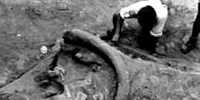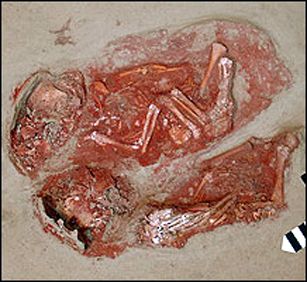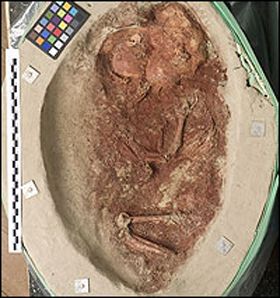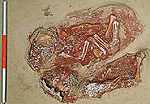Back to Don's Maps

The Krems-Wachtberg Pavlovian mammoth site in Austria on the Danube
Ice Age Babies from the Krems-Wachtberg site

Text from:http://www.sciam.com/
Images: Natural History Museum Vienna, Department of Anthropology
Researchers have unearthed the graves of three Stone Age infants that may ultimately bear on the question of whether humans interbred with Neanderthals. The rare find, from a 27 000 year old site in Austria, includes two bodies that might be twins sheltered under a mammoth's shoulder blade.
The team discovered the skeletons in two separate burial pits: One uncovered last year contained two infants side by side - twins, apparently. A second pit containing a single body was found this year about a meter from the first pit. The twins had been protected from the elements by the mammoth bone and were very well preserved, says team member Christine Neugebauer-Maresch of the Prehistoric Commission of the Austrian Academy of Sciences in Vienna. An incisor from one of the pair indicates they died at nine or ten months of age, the group reports in the November 16 Nature. Before this, "there were no graves of newborns at all," Neugebauer-Maresch says. "We think if there are two preserved it's possible there are much more."
Numerous traces of burial practice survived. All of the infant remains were covered in red pigment, and more than 30 ivory beads lay near the pelvis of one of the presumed twins. The lone skeleton contained an ivory pin, which may have held shut a leather or fur wrapping, Neugebauer-Maresch says.
The excavators found the remains in an 18 square metre site in lower Austria, near where the river Krems meets the Danube. The location contains a well preserved earthen floor and other artefacts characteristic of so-called Gravettian culture, including a fired piece of clay bearing a human fingerprint.

The second of two burial sites discovered in Austria contains a single Stone Age newborn.
The infant burials were similar to those for Gravettian adults, whose remains often include mammoth bones and jewellery, says anthropologist Olga Soffer of the University of Illinois at Urbana-Champaign. "What is unusual is the extreme youth of these," she says. "Dead kids are few and far between, and the younger you get the fewer there are." The effort taken to bury and decorate the remains implies the infants or their families were held in high esteem, she notes.
Studying the Austrian infants or any DNA extracted from them may contribute to the debate over whether or not humans and Neanderthals exchanged DNA, Soffer says. In recent weeks researchers have presented evidence that humans and Neanderthals interbred when humans left Africa 30 000 - 40 000 years ago. Human skeletons found in Romania seem to show certain Neanderthal traits, for example. The new remains could be examined for similar features, Soffer observes. "It will always be a little problematic because they're not mature, but it will be an important point of reference," she says. "There's lots and lots of exciting potential here."
- JR Minkel
From: http://smh.com.au/articles/2005/09/25/1127586747121.html
Miracle of life: Ice-Age babies
September 26, 2005
United ... these babies were born 27 000 years ago.
The 27 000-year-old skeletons of two Ice Age infants have been found near Krems in northern Austria, the first discovery of its kind in Europe, Austrian media have reported. The perfectly preserved skeletons, measuring 40 centimetres, had been protected by a mammoth's shoulder-blade, under which they had been buried on a sheltered hillside on the banks of the Danube. The grave, discovered 5.5 metres below ground, also contained a necklace of 31 beads made from mammoth ivory and was located next to an area inhabited by the ancient humans Homo sapiens fossils , newspapers reported.
"It is the first discovery of a child's grave dating from this period," the excavation manager, Christine Neugebauer-Maresch, confirmed to the newspaper Kurier . "They may have been twins, but we have not yet been able to establish that," she told Die Presse . The age of the skeletons will be analysed by scientists in Vienna, who will also determine the cause of death. Homo sapiens fossils came out of Asia during the Ice Age as Neanderthal man was dying out, and mastered stone and wood, but did not discover metal.
Agence France-Press
Photo: Reuters
http://news.yahoo.com/photos/ss/events/sc/021903anthroarchaeo
Anthropology & Archaeology
Reuters - Fri Sep 23,11:08 AM ET
A more than 27 000 year-old grave with the bodies of two babies is pictured near Krems in Lower Austria September 23, 2005. Archaeologists of the Prehistoric Commission of the Austrian Academy of Sciences (OeAW) excavated the bodies which were covered with an omoplate (scapula, shoulder blade) of a mammoth. This is the oldest grave ever found in Austria.
REUTERS/HO/OeAW Praehistorische Kommission
http://www.tirol.com/chronik/national/20214/index.do
27.000 Jahre alte Bestattung bei Krems entdeckt
Mit einem sensationellen, eiszeitlichen Fund können Archäologen der Österreichischen Akademie der Wissenschaften aufwarten.
Sie entdeckten auf dem Wachtberg bei Krems eine mehr als 27.000 Jahre alte Begräbnisstätte. Im Grab fanden sich die mit Grabbeigaben versehenen Skelette von zwei Säuglingen, möglicherweise Zwillinge. "Sie wurden liebevoll unter einem Mammut-Schulterblatt bestattet", erklärte Projektleiterin Christine Neugebauer-Maresch gegenüber der APA.
Im Raum Krems finden sich teilweise meterhohe Auflagerungen von Löss - ein sehr feines Staubsediment, das ursprünglich aus Flüssen stammt. Immer wieder entdecken Archäologen darin Kostbarkeiten aus der Eiszeit: So kam vor 17 Jahren die unter dem Namen "Fanny" bekannt gewordene steinerne Statuette bei Ausgrabungen in in Krems-Rehberg und Stratzing ans Tageslicht.
Bereits seit mehreren Jahren sind die Archäologen der Prähistorischen Kommission der ÖAW auf dem Wachtberg von Krems mit Unterstützung des Fonds zur Förderung der Wissenschaftlichen Forschung (FWF) tätig. Trotz einer Tiefe von über fünf Metern konnte so das Areal eines Behausungsplatzes geortet und gezielt als Forschungsobjekt ausgewählt werden. Die Funddichte übertraf laut Neugebauer-Maresch alle Erwartungen.
"In der etwa acht bis 15 Zentimeter mächtigen Kulturschichte mit einem Alter von rund 27.000 Jahren konnten auf bisher rund zehn Quadratmetern mehr als 10.000 Fundstücke dokumentiert und geborgen werden", berichtete die Wissenschafterin. Glanzstücke sind eine besonders feine Steinsäge, bearbeitete Klingen, Kratzer, ein feines Elfenbeinstäbchen und ein geformtes und gebranntes Tonobjekt.
Mitte September stießen die Archäologen dann auf eine Vertiefung unter der Kulturschicht, die durch ein Mammutschulterblatt abgedeckt war. Darunter fanden die Ausgräber eine mit rotem Farbstoff aufgefüllte Mulde, an deren Grund die zarten Knochen zweier Säuglinge lagen. Beim weiteren Freilegen der Skelettteile entdeckten die Forscher noch eine Kette aus Schmuckperlen. Dies ist für Neugebauer-Maresch ein weiterer, klarer Hinweise für einen Bestattungsritus, die Kette war offenbar den beiden Verstorbenen mitgegeben worden. Die Funde gelten nun als mit Abstand älteste Grabstätte Österreichs, die ersten Belege für Bestattungen aus der Eiszeit.
23.09.2005
Translation:
A burial site 27 000 years old has been discovered at Krems. It is a sensational ice-age find by archaeologists of the Austrian Academy of Sciences.
They discovered an old gravesite at Wachtberg bei Krems which was dated at more than 27 000 years old. (the Krems-Wachtberg area has a number of archaeological sites, one of a mammoth family which was hunted and body parts harvested, see the Krems-Wachtberg mammoth site also around 27 000 years old)
In the grave were skeletons of two babies who were possibly twins.
"They were affectionately laid to rest under a mammoth shoulder blade", said project chief Christine Neugebauer-Maresch from the APA.
In the Krems area are sometimes metre-deep deposits of Loess - a very fine dust sediment, which originates from rivers.
(??? Loess originates from wind blown dust from glacier activity. Perhaps they mean that the loess was reworked and redeposited by rivers)
In this area archaeologists have discovered many important finds from the ice age: Thus "Fanny", a stone Statuette also known as Venus vom Galgenberg was unearthed in Krems Rehberg and Stratzing 17 years ago.
For several years the archaeologists of the Prehistoric Commission of the OEAW Wachtberg bei Krems with the support of the fund have been active for the promotion of scientific research (FWF). Despite a depth of over five metres a dwelling place was located and selected as a research project. The density of the finds exceeded all expectations according to Neugebauer-Maresch.
"in a layer about eight to 15 centimetres thick a vigourous culture approximately 27 000 years old was documented and preserved, and in approximately ten square metres more than 10 000 artefacts were found", reported the scientist.
Amongst the gems found were a particularly fine "stonesaw", processed blades, scrapers, a fine small ivory rod and a ceramic object.
I have no idea whether the following is a correct understanding of the term "stonesaw", but I include it for general information in any case. I collect useless information, and it doesn't come more useless than this - which is precisely why it is both useful and instructive!
From:
http://www.primitiveways.com/stone_saw.html
Most people are familiar with stone axes and celts for cutting down trees. In central California neither of these tools are found in the archeological record, and most of the houses built were framed with relatively small diameter trees (1 - 3 inches). My experience of trying to cut down springy willows with a stone axe led me to believe there must be a better way.In the middle of September the archaeologists encountered a recess under the culture layer, on top of which a mammoth shoulder blade was placed. Beneath it the excavators found a hollow filled up with red colouring material, covering the bones of two babies.
After asking local archaeologists to no avail, I called Craig Bates, Curator of the Indian Museum in Yosemite, who told me about the historic use of a stone slab as a crosscut saw. Later I found documentation describing a group of four Indian men cutting down a tree. Two men used their carrying nets hooked together to catch and bend down the tree, the other two used a stone slab as a saw to cut the tree in about a minute. Working alone, I found it took me three to five minutes to cut down a willow 1.5 - 2 inches thick, bending it over with one hand and cutting with the other.
Over the past two summers I have undertaken the construction of a thatched central California Indian-style house using all stone age tools and materials. Using a straight 6 inch-long flake of metabasalt I had been given by a knapper friend, I created a stone saw. It was used to cut a one inch thick oak branch and split it part way. I inserted the flake into the split, creating a large "Hoko knife". (see photo)
The entire tool kit used to create the shelter frame: Abalone shell, basalt flakes, obsidian chopper, wooden maul, and hafted saw.
Then, with a group of volunteers, I set out to cut down a dozen 2 inch diameter willows for house poles. Using the hafted saw, we could cut down a tree in just over a minute with four people as in the ethnographic account. Other members of the group created some crude edged tools that we also tried. These took about three minutes or so, because of the difficulty in holding onto them. Some trees took longer simply because of their position, and the difficulty of getting them properly bent over. The largest size that would be practical to cut seems to be about 3 to 4 inches in diameter, at which size an axe begins to work more efficiently.
The stone saw works only on green wood, and only when the tree is bent over sharply. This allows the saw to cut without side friction and jamming. It cuts about an eighth of an inch per motion. If proper pressure is not applied to the base of the tree, a series of splits will form in the end of the piece. Pushing down on the end above the cut moves the splits down to the stump, or eliminates them altogether. When the position of the tree permits, it can be cut half way through and then bent back the other way for a final cut. Where the second bend was not practical, I found I could cut most of the way through and then simply stomp down above the cut and peel it away from the stump, or pull up on the pole and peel it away. Smaller poles for binding on the thatch took about 30 seconds to cut. The saw's efficiency was quite gratifying to all of us, as we got our poles cut and carried them back to the building site in about two hours, less than the time it would take me with a steel saw working alone (hauling would take longer).
When examining the skeletons the researchers discovered a necklace made of decorative beads. This is a further, clear reference for Neugebauer-Maresch for a burial rite, the necklace had obviously been given to both deceased. The findings now show Austria as having the first records of burial in the ice ages.
From New Scientist:
Ice age 'twins' found in ancient burial ground
18:23 27 September 2005NewScientist.com news service
Will Knight
The twins were buried side by side covered in red ochre (Image: Austrian Academy of Sciences) Two ice-age human infants, buried together with great ceremony, have been discovered on a hillside overlooking the Danube in Austria.
The pair, who may well be biological twins, were found near Krems in northern Austria by Christine Neugebauer-Maresch of the Austrian Academy of Sciences and her colleagues.
The remains have yet to be carbon-dated but are thought to be at least 27 000 years old, because other artefacts from the area have been dated to between 40 000 and 27 000 years old. During this period, which falls within the Upper Palaeolithic, Neanderthals were superseded by modern humans, who were developing increasingly sophisticated hunting abilities and forms of culture.
The babes were placed side by side in their grave and protected beneath a woolly mammoth's shoulder blade, which was propped up by pieces of mammoth tusk. The bodies were wrapped in a material such as animal hide that has since deteriorated and were covered with ochre.
Neugebauer-Maresch told New Scientist that more than 31 ivory beads were also found at the burial site. "They had been buried with much ritual - it is really very interesting," she says.
Structural remains The "twins" were found on 21 September 2005 at a depth of five metres after speculative drilling of cores within a wider area had already yielded many structural remains and stone artefacts. These are, however, the first human remains to be found at the site.
The pair has been moved to Vienna's Natural History Museum, where they will be examined further and carbon-dated by Maria Teschler-Nicole. She will place the remains within a chamber with controlled humidity in order to limit further deterioration.
Teschler-Nicole has already found that both babies' femurs measure 71 millimetres in length, which suggests they were newborn and also that the pair were related. "The probability that they are twins is high," she told New Scientist . "But we can't prove it without DNA or teeth fragments."
She says there may be insufficient organic material to extract useful DNA from the pair.
A computer-assisted tomography (CT) scan conducted at Vienna General Hospital has shown another set of beads concealed beneath one of the baby's heads

